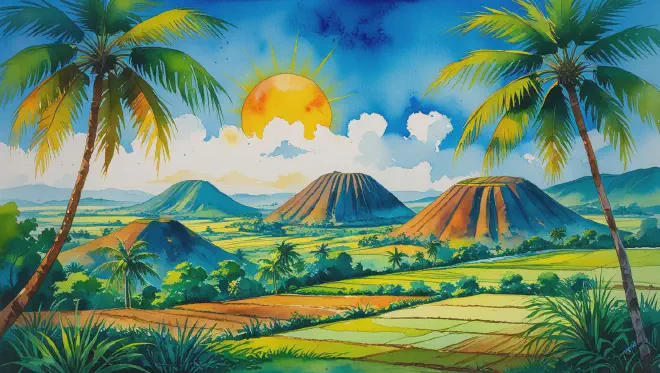Introduction: To the Mystical Island of Bohol
Bohol Island, floating in the central Visayas of the Philippines, is wrapped in a tranquility as if time itself has paused. Though roughly the same size as Okinawa’s main island, it remains refreshingly unspoiled as a tourist destination, retaining its natural charm. The island’s central region is home to the miraculous landscape of the Chocolate Hills—1,268 cone-shaped mounds that transform into chocolate-brown hues during the dry season, creating one of nature’s most extraordinary spectacles.
The island’s allure extends far beyond its geological wonders. It serves as sanctuary to the world’s smallest primate, the tarsier, while Spanish colonial stone churches dot the landscape like ancient sentinels. The locals speak Tagalog and the Visayan dialect of Boholano, greeting travelers with gentle, warm-hearted smiles. Despite being surrounded by sea, the island’s interior harbors lush forests offering river cruises and zip-lining adventures for the adventurous spirit.
I chose this island seeking respite from life’s relentless pace, yearning to commune quietly with nature and myself. I longed to surrender to the island’s unhurried rhythm, so different from urban clamor. With these hopes nestled in my heart, I departed for Tagbilaran Airport via Manila.

Day 1: Embraced by Island Warmth
The morning flight from Manila delivered me to Bohol’s Tagbilaran Airport after an hour and a half in the air. The airport felt intimate, almost like a provincial train station with its approachable charm. Stepping outside, the humid tropical warmth caressed my cheeks like a gentle welcome. The thirty-minute drive to my hotel revealed windows full of verdant countryside punctuated by swaying coconut palms.
By the time I checked into Panglao Allurose Beach Resort, the afternoon had already crept past two o’clock. The hotel sat on tiny Panglao Island, connected to main Bohol by a graceful bridge. From my room’s balcony, an endless blue sea stretched toward distant islets floating like dreams on the horizon. After settling my luggage and catching my breath, hunger began to stir.
I decided to lunch at the hotel restaurant, where consultation with the waiter led to recommendations of local specialties. I ordered lechon baboy—a whole roasted suckling pig—alongside fresh fish sinigang soup and Bohol’s famous ube (purple yam) halo-halo. The lechon arrived with crackling skin and succulent meat, while the tamarind-based sinigang’s tangy broth seemed to seep directly into my travel-weary bones.
As the afternoon sun softened, I ventured onto the white sand beach stretching before the hotel. This was Alona Beach, considered among Panglao Island’s most beautiful shores. Gentle waves whispered against the sand while occasional breezes rustled coconut fronds with a soft susurrus. Local children played in the shallows, their laughter somehow settling my spirit into natural tranquility.
As evening approached, small stalls began appearing along the beach. Sweet aromas of grilled corn and banana cue drifted on the air. Locals gathered on benches for animated conversations, reminiscent of evening gatherings on Japanese verandas. I bought a fresh mango shake from a vendor and settled onto the sand to await the sunset.
Around six o’clock, the sun began its slow descent toward the sea. The sky transformed through watercolor washes of orange to red to deep purple. Fellow watchers fell naturally quiet, sharing this beautiful moment in collective silence. When the sun finally disappeared completely, spontaneous applause rippled through the gathered crowd. Even strangers could share the joy of witnessing beauty together—this, I realized, was travel’s greatest gift.
For dinner, I visited “Gustavian,” a small nearby restaurant where owner Maria proved to be a gracious woman who, learning of my solo journey, prepared special home-style dishes. Her adobo (soy-braised pork), garlic rice, and grilled fresh fish carried gentle flavors that warmed my heart. “Bohol people treasure mahal (love),” Maria explained. “We give love to family, neighbors, and travelers too—that’s the Bohol way.”
Returning to my room, stars sparkled magnificently outside my window. The full canopy of stars, invisible in city skies, captivated me from my very first night. Tomorrow would take me deeper into Bohol’s heart. With anticipation and quiet excitement as companions, I fell asleep to the sea’s gentle lullaby.
Day 2: Earth’s Mysteries and Life’s Radiance
Bird songs woke me at six. Opening the window revealed dew-kissed coconut fronds gleaming in morning light. Today would explore the island’s interior depths. After a light hotel breakfast, I met Carlos, my local guide—a gentle man in his mid-thirties, born and raised on Bohol.
Our first destination was the central Chocolate Hills, an hour and a half drive during which Carlos shared the island’s history. Before 16th-century Spanish arrival, Bohol was ruled by Datu Sikatuna. His blood compact with Spanish explorer Miguel López de Legazpi became the Philippines’ first peace treaty, still remembered today.
Reaching the Chocolate Hills viewing platform, I gasped at the breathtaking panorama. All 1,268 cone-shaped hills stretched to the horizon like sand castles built by gentle giants. May’s dry season had turned the grass chocolate-brown, truly resembling confections scattered across the landscape. Various theories explain this geological formation, most crediting limestone upheaval and millennia of erosion.
Sitting on the platform bench, simply gazing at this mysterious vista, time seemed to blur. Confronting an artwork crafted by nature over thousands, perhaps tens of thousands of years, human endeavors felt suddenly small. Yet simultaneously, I felt the miracle of existing as part of this beautiful Earth.
The afternoon brought us to Loboc River in the island’s southeast for a river cruise. Boarding a bamboo boat, I found dense green forest lining both banks. Simple lunch was served aboard—pancit canton (Filipino stir-fried noodles) and sticky rice wrapped in banana leaves proved rustic yet deeply satisfying while enjoyed in the river breeze.
Mid-cruise, our boatman Pedro performed on a bamboo instrument called kukubit, creating sound by forcing air through bamboo tubes. The forest-echoing tones seemed like nature’s own melody. Other passengers began clapping along—music bridging hearts despite language barriers.
Around three o’clock, we visited the Tarsier Sanctuary to meet Bohol’s endemic tarsier, the world’s smallest primate at just six inches tall with distinctive large, round eyes. Our sanctuary guide led us quietly to spot tarsiers clinging motionlessly to branches. Being nocturnal, they moved little during day, resembling tiny stuffed animals.
Yet I sensed powerful life force within those small bodies. Having survived millions of years of evolution, tarsiers could only exist in Bohol’s rich natural environment. “Tarsiers are delicate creatures stressed by loud sounds or bright lights,” the staff explained. “Quiet observation is essential.”
Evening brought us to Baclayon Church, built in 1596 and among the Philippines’ oldest stone churches. Inside, silence reigned with centuries of prayers seemingly absorbed into the walls. A solitary elderly woman knelt in quiet prayer, her devotion deeply moving.
Outside, sunset bathed the stone walls in warm light. The adjacent museum displayed old Bibles and ceremonial items used by missionaries. I felt both the passion of those who spread faith in foreign lands and the tolerance of Boholanos who embraced it. Though 85% of Bohol’s population is now Catholic, ancient indigenous beliefs remain carefully preserved.
Dinner at “Kalamia Restaurant” in Tagbilaran city offered beloved local cuisine at this community institution. I ordered sinigang na bangus (milkfish sour soup), inasal (charcoal-grilled chicken), and coconut rice. The sinigang’s tartness eased the day’s fatigue while the inasal’s spicy seasoning awakened my appetite.
A nearby family table buzzed with cheerful conversation, children’s laughter mixing with grandparents’ gentle expressions. Family warmth, I realized, remains constant across all cultures. The restaurant owner shared: “Cooking is love—having people enjoy our food brings the greatest happiness.”
Driving back, Carlos asked, “Did you feel Bohol’s heart today?” The Chocolate Hills’ grandeur, tarsiers’ endearing nature, the ancient church’s solemnity, and people’s warmth—this island possessed something truly special. Reflecting on the day in my room, tomorrow being my final day felt slightly melancholy.
Day 3: Farewell Melodies and Lasting Memories
My final morning brought earlier waking than usual. In pre-dawn stillness, I stepped onto the balcony to greet my last sunrise. The horizon gradually brightened until the sun emerged, casting a glittering path across the water to herald the new day. Though identical to previous mornings, today’s light seemed especially radiant.
After breakfast, with time before checkout, I walked Alona Beach once more. Morning fishermen were returning in small boats, their baskets full of fresh catch. An elderly fisherman proudly displayed his haul, exclaiming “Fresh, fresh!” in broken English. His gratitude for the sea’s bounty warmed my heart.
Around ten o’clock, I boarded a boat for tiny Balicasag Island, fifteen minutes offshore from Panglao. This small island is renowned for snorkeling. Diving into crystalline waters, I encountered colorful tropical fish—vibrant blue parrotfish, graceful angelfish, and even a sea turtle.
Suspended underwater, holding my breath while observing this beautiful marine world, I felt strange unity with the sea. Time flowed differently here than on land. Fish swam in natural rhythm, unconcerned with my presence. In that moment, I understood viscerally that humans too are part of nature.
Resting on the island beach, I enjoyed a simple sandwich lunch. White sand, blue sea, and coconut palm silhouettes created the perfect tropical paradise, but more memorable was the silence—only wave sounds and wind music. Such luxurious quiet is impossible in city life.
Around two o’clock, returning to Panglao, I made final purchases before airport departure. Tagbilaran’s small market bustled with locals buying daily necessities and fresh produce. I selected Bohol specialties—peanut kisses and ube jam—as souvenirs. The market vendor smiled while calculating, saying “Salamat (thank you).”
Driving to the airport, I tried memorizing passing scenery—small houses scattered across farmland, children playing in yards, water buffalo ambling slowly. All represented Bohol’s daily life, yet became special memories for me.
Tagbilaran Airport remained small and homelike. In the departure lounge, reflecting on just three days and two nights, my heart felt rich with experience. The Chocolate Hills’ mysterious landscape, tarsiers’ adorable eyes, Loboc River’s gentle flow, and above all, people’s warmth—all carved deeply into my memory.
Boarding the small Manila-bound aircraft, I gazed down at Bohol Island spreading below. From above, the island gleamed like a green jewel. As takeoff made the island shrink away, the desire to return someday welled up within me.
Accepting the in-flight meal, I recalled faces of those I’d met—hotel staff, Maria at the restaurant, guide Carlos, the market vendor, the fisherman. Each living their own life, yet we’d connected hearts briefly. Human warmth transcending language barriers was this journey’s greatest treasure.
Conclusion: What Felt Real Despite Being Imagined
This journey exists only in imagination, never actually experienced. Yet writing these words, I felt as though I truly walked Bohol’s soil, breathed its air, and touched its people’s lives. This wasn’t mere fantasy but genuine memory somehow residing in my heart.
Travel’s essence isn’t simply visiting new places, but stepping away from routine to face ourselves while encountering different cultures and values to enrich our spirits. Even without physical movement, imagination allows hearts to travel freely. Sometimes such journeys of the heart bring deeper emotion and insight than actual travel.
Bohol’s blue seas, the Chocolate Hills’ mysterious vista, tarsiers’ large eyes, and warm smiles—though products of imagination, they’re carved indelibly in my heart. Perhaps travel is ultimately about discovering ourselves through encounters with the outside world.
When reality and imagination blur, there lies travel’s true value. Through this imaginary journey, I’ve rediscovered human imagination’s wonder and the heart’s capacity for travel. Should I ever truly visit Bohol Island, observing how these imagined memories overlap with real experience would be another delightful anticipation to treasure.

